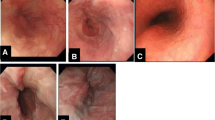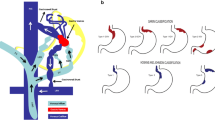Abstract
Endoscopic therapy is the principal method of treatment for esophageal varices. The recurrence of varices is still common following endoscopic treatment. The aim was to identify predictive factors for variceal recurrence detected by endosonography. We performed a systematic review of studies published prior to June 2013. Studies analyzing gastroesophageal collateral veins as risk factors for variceal recurrence after endoscopic treatment were included. The primary outcome was to identify predictive factors for variceal recurrence investigated by endosonography. After a full-text review, 13 studies were included in our analysis. Analysis of risk factors was not possible for all studies included. Perforating veins and periesophageal collateral veins were related to a higher risk of variceal recurrence (OR = 3.93; 95 % CI 1.06–14.51; I 2 = 96 %; OR = 2.29; 95 % CI 1.58–3.33; I 2 = 55 %). Analysis of cardiac intramural veins and paragastric/cardiac collateral veins showed the same trend, but without reaching statistical significance because of the small group size and wide CI (OR = 3.72; 95 % CI 0.14–101.53; I 2 = 91 %; OR = 1.85; 95 % CI 0.84–4.07; I 2 = 0 %). Analysis of other collateral veins as risk factors for variceal recurrence and analysis of risk factors with regard to the endoscopic treatment method was not possible because of the limited number of cases and different methodologies. A positive association between variceal recurrence and type and grade of collateral veins, investigated by endosonography, was demonstrated. Endosonography is a promising tool for predicting recurrence of esophageal varices following endoscopic treatment. These findings should be interpreted with caution because of the heterogeneity of the studies.




Similar content being viewed by others
References
Blei AT. Portal hypertension and its complications. Curr Opin Gastroenterol. 2007;23(3):275–282
Garcia-Tsao G, Sanyal AJ, Grace ND, Carey WD. Prevention and management of gastroesophageal varices and variceal hemorrhage in cirrhosis. Hepatology. 2007;46(3):922–938
Pagliaro L, D’Amico G, Pasta L, Politi F, Vizzini G, Traina M, et al. Portal Hypertension in Cirrhosis: Natural History. In: Bosch J, Groszmann RJ, editors. Portal Hypertension, Pathophysiology and Treatment. Oxford: Blackwell Scientific; 1994. 72–92
D’Amico G. Esophageal Varices: From Appearance to Rupture; Natural History and Prognosis Indicators. In Groszmann RJ, editor. Portal Hypertension in the 21st Century. Dordrecht 2004. 147–154
The North Italian Endoscopic Club for the Study and Treatment of Esophageal Varices. Prediction of the first variceal hemorrhage in patients with cirrhosis of the liver and esophageal varices. A prospective multicentre study. N Engl J Med 1988;319:983–989
Graham DY, Smith JL. The course of patients after variceal hemorrhage. Gastroenterology. 1981;80(4):800–809
D’Amico G, De Franchis R. Upper digestive bleeding in cirrhosis. Post-therapeutic outcome and prognostic indicators. Hepatology. 2003;38:599–612
Stokkeland K, Brandt L, Ekbom A, Hultcrantz R. Improved prognosis for patients hospitalized with esophageal varices in Sweden 1969–2002. Hepatology. 2006;43(3):500–505
Augustin S, González A, Genescà J. Acute esophageal variceal bleeding: current strategies and new perspectives. World J Hepatol. 2010;2(7):261–274
Stiegmann GV, Goff JS, Michaletz-Onody PA, Korula J, Lieberman D, Saeed ZA, et al. Endoscopic sclerotherapy as compared with endoscopic ligation for bleeding esophageal varices. N Engl J Med. 1992;326(23):1527–1532
Hou MC, Lin HC, Kuo BI, Chen CH, Lee FY, Lee SD. Comparison of endoscopic variceal injection sclerotherapy and ligation for the treatment of esophageal variceal hemorrhage: a prospective randomized trial. Hepatology. 1995;21(6):1517–1522
Fakhry S, Ömer M, Nouh A. Endoscopic sclerotherapy versus endoscopic variceal ligation in the management of bleeding esophageal varices: a preliminary report of a prospective randomized study in schistosomal hepatic fibrosis. Hepatology. 1995;22:251A
Avgerinos A, Armonis A, Manolakopoulos S, Avgerinos A, NArmonis A, Manolakopoulos S, et al. Endoscopic sclerotherapy versus variceal ligation in the long-term management of patients with cirrhosis after variceal bleeding. A prospective randomized trial. J Hepatol 1997;26(5):1034–1041
Baroncini D, Milandri GL, Borioni D, Piemontese A, Cennamo V, Billi P, et al. A prospective, randomized trial of sclerotherapy versus ligation in the elective treatment of bleeding esophageal varices. Endoscopy 1997;29(4):235–240
Lahbabi M, Mellouki I, Aqodad N, Elabkari M, Elyousfi M, Ibrahimi SA, et al. Esophageal variceal ligation in the secondary prevention of variceal bleeding: result of long term follow-up. Pan Afr Med J. 2013;15:3
Sarin SK, Govil A, Jain AK, et al. Prospective randomized trial of Endoscopic sclerotherapy versus variceal band ligation for esophageaL varices: influence on gastropathy, gastric varices and variceal recurrence. J Hepatol. 1997;26:826–832
Hou MC, Lin HC, Lee FY, Chang FY, Lee SD. Recurrence of esophageal varices following endoscopic treatment and its impact on rebleeding: comparison of sclerotherapy and ligation. J Hepatol. 2000;32:202–208
McCormack TT, Smith PM, Rose JD, Johnson AG. Perforating veins and blood flow in oesophageal varices. Lancet. 1983;2:1244–1442
Caletti GC, Bolondi L, Arienti V, et al. Assessment of gastroesophageal collateral veins in portal hypertension by means of endoscopic ultrasonography. Gut. 1983;24:A45
Tajiri T, Yoshida H, Obara K, et al. General rules for recording endoscopic findings of esophagogastric varices (2nd edition). Digest Endosc. 2010;22:1–9
Kume K, Yamasaki M, Watanabe T, Yoshikawa Y, Otsuki M, Harada M. Mild collateral varices and a fundic plexus without perforating veins on EUS predict endoscopic non-recurrence of esophageal varices after EVL. Hepatogastroenterology. 2011;58:798–801
Sato T, Yamazaki K, Toyota J, Karino Y, Ohmura T, Akaike J. Endoscopic ultrasonographic evaluation of hemodynamics related to variceal relapse in esophageal variceal patients. Hepatol Res. 2009;39:126–133
Seno H, Konishi Y, Wada M, Fukui H, Okazaki K, Chiba T. Endoscopic ultrasonographic evaluation of vascular structures in the gastric cardia predicts esophageal variceal recurrence following endoscopic treatment. J Gastroenterol Hepatol. 2006;21:227–231
Ishii S, Kakemura T, Fujinuma S, Sakai Y. Endoscopic ultrasosnography findings and clinical backgrounds in cases with early recurrence of esophageal varices after endoscopic injection sclerotheraoy. Dig Endosc. 2005;17:310–317
Shibukawa G, Irisawa A, Saito A, et al. Variceal recurrence after endoscopic sclerotherpy associated with the perforating veins in lower esophagus independently. Hepatogastroenterology. 2004;51:744–747
Irisawa A, Obara K, Bhutani M, et al. Role of para-esophageal collateral veins in patients with portal hypertension based on the results of endoscopic ultrasonography and liver scintigraphy analysis. J Gastroenterol Hepatol. 2003;18:309–314
Konishi Y, Nakamura T, Kida H, Seno H, Okazaki K, Chiba T. Catheter US probe EUS evaluation of gastric cardia and perigastric vascular structures to predict esophageal variceal recurrence. Gastrointest Endosc. 2002;55:197–203
Irisawa A, Saito A, Obara K, et al. Endoscopic recurrence of esophageal varices is associated with the specific EUS abnormalities: severe peri-esophageal collateral veins and large perforating veins. Gastrointest Endosc. 2001;53(1):77–84
Suzuki T, Matsutani S, Umebara K, et al. EUS changes predictive for recurrence of esophageal varices in patients treated by combined endoscopic ligation and sclerotherapy. Gastrointest Endosc. 2000;52:611–617
Sato T, Yamazaki K, Toyota J, Karino Y, Ohmura T, Suga T. Perforating veins in recurrent esophageal varices after endoscopic therapy visualized by endoscopic color doppler ultrasonography. Dig Endosc. 1999;11:236–240
Lo GH, Lai KH, Cheng JS, Huang, Wang SJ, Chiang HT. Prevalence of paraesophageal varices and gastric varices in patients achieving variceal obliteration by banding ligation and by injection sclerotherapy. Gastrointest Endosc 1999; 49:428–436
Leung V, Sung J, Ahuja AT, et al. Large paraesophageal varices on endosonography predict recurrence of esophageal varices and rebleeding. Gastroenterolog. 1997;112:1811–1816
Dhiman RK, Choudhuri G, Saraswat VA, Agarwal DK, Naik SR. Role of paraoesophageal collaterals and perforating veins on outcome of endoscopic sclerotherapy for oesophageal varices: an endosonographic study. Gut. 1996;38:759–764
Villanueva C, Sancho-Poch F. Balanz Jea. Esophagic histophathologic changes induced by variceal sclerosing therapy. Gastroenterol Hepatol. 1990;13:15–19
Nakamura H, Endo M, Shumojuu K, et al. Esophageal varices evaluated by endoscopic ultrasonography: observation of collateral circulation during non-shunting operations. Surg Endosc. 1990;4:69–75
Kitano S, Terblanche J, Kahn D, et al. Venous anatomy of the lower esophagus in portal hypertension: practical implications. Br J Surg. 1986;73:525–531
Acknowledgements
No funding has been received for this work.
Compliance with ethical requirements and Conflict of interest
Laura Masalaite, Jonas Valantinas, Juozas Stanaitis declare that they have no ethical conflicts. Laura Masalaite, Jonas Valantinas, Juozas Stanaitis declare that they havo no conflicts of interest. No funding has been recieved for this work.
Author information
Authors and Affiliations
Corresponding author
Rights and permissions
About this article
Cite this article
Masalaite, L., Valantinas, J. & Stanaitis, J. The role of collateral veins detected by endosonography in predicting the recurrence of esophageal varices after endoscopic treatment: a systematic review. Hepatol Int 8, 339–351 (2014). https://doi.org/10.1007/s12072-014-9547-3
Received:
Accepted:
Published:
Issue Date:
DOI: https://doi.org/10.1007/s12072-014-9547-3




